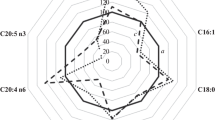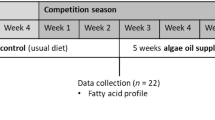Abstract
The effect of intensive long-term physical activity on phospholipid fatty acid (FA) composition has not been studied thoroughly. We determined plasma and erythrocyte phospholipid FA status of professional basketball and football players. Our results showed differences in plasma FA profile not only between sportsmen and sedentary subjects, but also between two groups of sportsmen. Plasma FA profile in basketball players showed significantly higher proportion of n-6 FA (20:3, 20:4, and 22:4) and total polyunsaturated FA (PUFA) than controls, while football players had higher palmitoleic acid (16:1) than basketball players and controls. Total PUFA and 22:4 were also higher in basketball than in football players. Erythrocyte FA profile showed no differences between football players and controls. However, basketball players had higher proportion of 18:0 than controls, higher saturated FA and lower 18:2 than two other groups, and higher 22:4 than football players. These findings suggest that long-term intensive exercise and type of sport influence FA profile.
Similar content being viewed by others
References
Aellen R, Hollmann W, Boutellier U (1993) Effects of aerobic and anaerobic training on plasma lipoproteins. Int J Sports Med 14:396–400
Allard C, Alteresco M, Ferguson RJ et al (1973) Changes in adipose tissue and increased serum cholesterol of coronary patients following training. Can Med Assoc J 109:194–197
Andersson A, Sjodin A, Hedman A et al (1998) Effects of physical exercise on phospholipid fatty acid composition in skeletal muscle. Am J Physiol 274:E432–E438
Andersson A, Sjodin A, Hedman A et al (2000) Fatty acid profile of skeletal muscle phospholipids in trained and untrained young men. Am J Physiol Endocrinol Metab 279:E744–E751
Borsheim E, Knardahl S, Hostmark AT (1999) Short-term effects of exercise on plasma very low density lipoproteins and fatty acids. Med Sci Sports Exerc 31:522–530
Christopherson SW, Glass RL (1969) Preparation of milk methyl esters by alcoholysis in an essentially nonalcoholic solution. J Daily Sci 52:1289–1290
Clemens MR, Ruess M, Bursa Z et al (1987) The relationship between lipid composition of red blood cells and their susceptibility to lipid peroxidation. Free Radic Res Commun 3:265–271
Dane S, Can S, Gursoy R et al (2004) Sport injuries: relations to sex, sport, injured body region. Percept Mot Skills 98:519–524
Folch J, Lees M, Stanley-Sloane GH (1957) A simple method for isolation and purification of total lipids from animal tissue. J Biol Chem 226:497–523
Friedewald WT, Levy RI, Fredrickson DS (1972) Estimation of the concentration of low-density lipoprotein cholesterol in plasma without use of the preparative ultracentrifuge. Clin Chem 18:499–502
Gleeson M, Bishop NC (1999) Immunology Basic and applied sciences for sports medicine. Oxford, Butterworth Heinemann, pp 199–236
Hall PE, Smith SR, Jack DB et al (1987) The influence of beta-adrenoceptor blockade on the lipolytic response to exercise. J Clin Pharm Ther 12:101–106
Hambleton PL, Slade LM, Hamar DW et al (1980) Dietary fat and exercise conditioning effect on metabolic parameters in the horse. Anim Sci 51:1330–1339
Harth S, Dreyfus H, Urban PF et al (1978) Direct thin-layer chromatography of gangliosides of total lipid extracts. Anal Biochem 86:543–551
Hashimoto M, Shinozuka K, Tanabe Y et al (1999) Hypotension induced by exercise is associated with enhanced release of adenyl purines from aged rat artery. Am J Physiol Heart Circ Physiol 276:H970–H975
Helge JW, Ayre KJ, Hulbert AJ et al (1999) Regular exercise modulates muscle membrane phospholipid profile in rats. J Nutr 129:1636–1642
James MJ, Gibson RA, Cleland LG (2000) Dietary polyunsaturated fatty acids and inflammatory mediator production. Am J Clin Nutr 71:343S–348S
Kamada T, Tokuda S, Aozaki S et al (1993) Higher levels of erythrocyte membrane fluidity in sprinters and long-distance runners. J Appl Physiol 74:354–358
Katan MB, Deslypere JP, van Birgelen AP et al (1997) Kinetics of the incorporation of dietary fatty acids into serum cholesteryl esters, erythrocyte membranes, and adipose tissue: an 18-month controlled study. J Lipid Res 38:2012–2022
Kogteva GS, Bezuglov VV (1998) Unsaturated fatty acids as endogenous bioregulators. Biochemistry 63:4–12
Kratchler B, Norberg M, Eriksson JW et al (2008) Fatty acid profile of the erythrocyte membrane preceding development of type 2 diabetes mellitus. Nutr Metab Cardiovasc Dis 18:503–510
Lopes-Virela MF, Stone P, Ellis S et al (1977) Cholesterol determination in high-density lipoproteins separated by three different methods. Clin Chem 23:882–886
McArdle W, Katch F, Katch V (1995) Fisiologia del ejercicio. Energia, nutricion y rendimiento humano, 2nd edn. Alianza Editorial, Madrid, pp 119–136
McMurchie EJ, Margetts BM, Beilin LJ et al (1996) Dietary-induced changes in the fatty acid compositionof human cheek cell phospholipids: correlation with changes in the dietary polyunsaturated/saturated fat ratio. Am J Clin Nutr 39:975–980
Mougios V, Kotzamanidis C, Koutsari C et al (1995) Exercise induced changes in the concentration of individual fatty acids and triacylglycerols of human plasma. Metabolism 44:681–688
Nakano T, Wada Y, Matsumura S (2001) Membrane lipid components associated with increased filterability of erythrocytes from long-distance runners. Clin Hemorheol Microcirc 24:85–92
Nikkari T, Lukkainen P, Pietinen P et al (1995) Fatty acid composition of serum lipid fractions in relation to gender and quality of dietary fat. Ann Med 27:491–498
Nikolaidis MG, Mougios V (2004) Effects of exercise on the fatty acid composition of blood and tissue lipids. Sports Med 34:1015–1076
Nikolaidis MG, Petridou A, Matsakas A et al (2004) Effect of chronic wheel running on the fatty acid composition of phospholipids and triacylglycerols in rat serum, skeletal muscle and heart. Acta Physiol Scand 181:199–208
Okita M, Yoshida S, Yamoto et al. (1995) n-3 and n-6 fatty acid intake and serum phospholipidfatty acid composition in middle-aged women living in rural and urban areas in Okayama perfecture. J Nutr Sci Vitaminol 41:313–323
Ostrowski K, Rohde T, Asp S et al (1999) Pro- and anti-inflammatory cytokine balance in strenuous exercise in humans. J Physiol 515:287–291
Quiles JL, Huertas JR, Ochoa JJ et al (2003) Dietary fat (virgin olive oil or sunflower oil) and physical training interactions on blood lipids in the rat. Nutrition 19:363–368
Ruiz JR, Mesa LM, Mingorance I et al (2004) Sports requiring stressful physical exertion cause abnormalities in plasma lipid profile. Rev Esp Cardiol 57:499–506
Shohet SB, Nathan DG (1970) Incorporation of phosphatide precursors from serum to erythrocytes. Biochim Biophys Acta 202:202–205
Smith JA, Martin DT, Telford RD et al (1999) Greater erythrocyte deformability in world-class endurance athletes. Am J Physiol Heart Circ Physiol 276:H2188–H2193
Spector AA, Yorek MA (1985) Membrane lipid composition and cellular function. J Lipid Res 26:1015–1035
Szabo A, Romvari R, Febel H et al (2002) Training induced alterations of the fatty acid profile of rabbit muscles. Acta Vet Hung 50:357–364
Thomas TR, Londeree BR, Gerhardt KO et al (1977) Fatty acid profile and cholesterol in skeletal muscle of trained and untrained young men. J Appl Physiol 43:709–713
Turner N, Lee JS, Bruce CR et al (2004) Greater effect of diet than exercise training on the fatty acid profile of rat skeletal muscle. J Appl Physiol 96:974–980
Wirth A, Neermann G, Eckert W et al (1979) Metabolic response to heavy physical exercise before and after a 3-month training period. Eur J Appl Physiol Occup Physiol 41:51–59
Wirth A, Heuck CC, Holm G et al (1980) Changes in the composition of fatty acids of total lipids in various tissues and serum due to physical training and food restriction in the rat. Scand J Clin Lab Investig 40:55–62
Acknowledgments
This work was supported by the Project 145071 financed by the Ministry of Science of the Republic of Serbia.
Author information
Authors and Affiliations
Corresponding author
Rights and permissions
About this article
Cite this article
Tepsic, J., Vucic, V., Arsic, A. et al. Plasma and erythrocyte phospholipid fatty acid profile in professional basketball and football players. Eur J Appl Physiol 107, 359–365 (2009). https://doi.org/10.1007/s00421-009-1131-5
Accepted:
Published:
Issue Date:
DOI: https://doi.org/10.1007/s00421-009-1131-5




